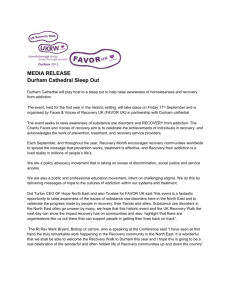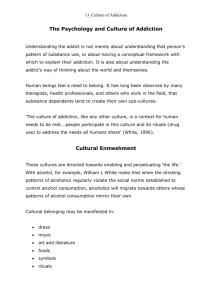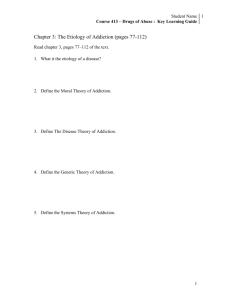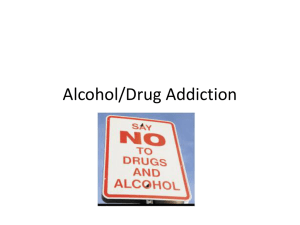Chronology of the Addiction Recovery Advocacy Movement
advertisement
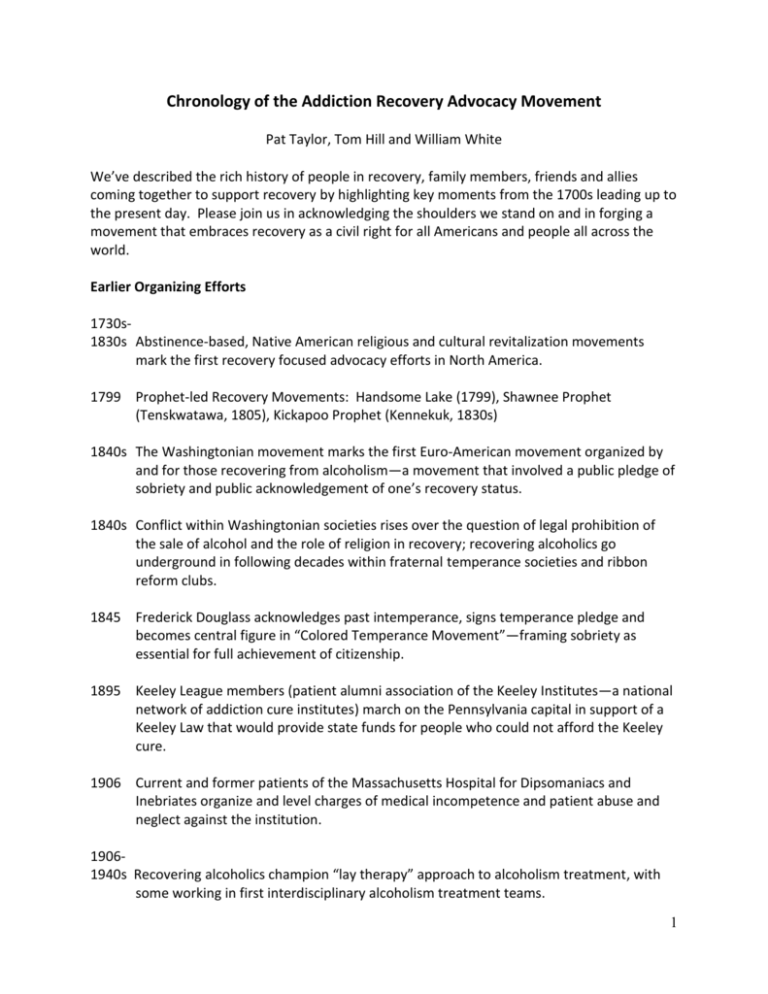
Chronology of the Addiction Recovery Advocacy Movement Pat Taylor, Tom Hill and William White We’ve described the rich history of people in recovery, family members, friends and allies coming together to support recovery by highlighting key moments from the 1700s leading up to the present day. Please join us in acknowledging the shoulders we stand on and in forging a movement that embraces recovery as a civil right for all Americans and people all across the world. Earlier Organizing Efforts 1730s1830s Abstinence-based, Native American religious and cultural revitalization movements mark the first recovery focused advocacy efforts in North America. 1799 Prophet-led Recovery Movements: Handsome Lake (1799), Shawnee Prophet (Tenskwatawa, 1805), Kickapoo Prophet (Kennekuk, 1830s) 1840s The Washingtonian movement marks the first Euro-American movement organized by and for those recovering from alcoholism—a movement that involved a public pledge of sobriety and public acknowledgement of one’s recovery status. 1840s Conflict within Washingtonian societies rises over the question of legal prohibition of the sale of alcohol and the role of religion in recovery; recovering alcoholics go underground in following decades within fraternal temperance societies and ribbon reform clubs. 1845 Frederick Douglass acknowledges past intemperance, signs temperance pledge and becomes central figure in “Colored Temperance Movement”—framing sobriety as essential for full achievement of citizenship. 1895 Keeley League members (patient alumni association of the Keeley Institutes—a national network of addiction cure institutes) march on the Pennsylvania capital in support of a Keeley Law that would provide state funds for people who could not afford the Keeley cure. 1906 Current and former patients of the Massachusetts Hospital for Dipsomaniacs and Inebriates organize and level charges of medical incompetence and patient abuse and neglect against the institution. 19061940s Recovering alcoholics champion “lay therapy” approach to alcoholism treatment, with some working in first interdisciplinary alcoholism treatment teams. 1 1942 Anderson, D. (Dwight) Alcohol and Public Opinion. Quarterly Journal of Studies on Alcohol, 3(3):376-392 Anderson presents his “kinetic ideas”: “1. That the problem drinker is a sick man, exceptionally reactive to Alcohol, 2. That he can be helped. 3. That he is worth helping. 4. That the problem is therefore a responsibility of the healing professions, as well as of the established health authorities and the public generally.” 1944 Mrs. Marty Mann founds the National Committee for Education on Alcoholism which will evolve into the National Council on Alcoholism and today’s National Council on Alcoholism and Drug Dependence (NCADD). In Formation of a National Committee for Education on Alcoholism, Quarterly Journal of Studies on Alcohol, 5(2):354. Mann outlines the five ideas that will be at its core: “1. Alcoholism is a disease. 2. The alcoholic, therefore, is a sick person. 3. The alcoholic can be helped. 4. The alcoholic is worth helping. 5. Alcoholism is our No. 4 public health problem, and our public responsibility.” 1956 Hospitalization of Patients with Alcoholism. (1956). Journal of the American Medical Association, October 20. AMA resolution on admitting alcoholics to general hospitals does not explicitly state that alcoholism is a disease but does refer to the alcoholic as a “sick individual”: the acknowledgment (resolution) of alcoholism as a disease will not pass until 1967. The 1956 resolution states: “Hospitals should be urged to consider admission of such patients with a diagnosis of alcoholism based upon the condition of the individual patient, rather than a general objection to all such patients.” 1958 The Association of Halfway House Alcoholism Programs of North America (AHHAP) founded. 1967 The American Medical Association passes a resolution that “alcoholism is a disease that merits the serious concern of all members of the health professions.” 1969 US Senator Harold Hughes (D-Iowa), a self-described recovered alcoholic, chairs Congressional hearing that led to passage of the 1970 Comprehensive Alcoholism Prevention and Treatment Act. Witnesses testifying include AA co-founder Bill Wilson and Mrs. Marty Mann of the National Council on Alcoholism. 1973 The Committee of Concerned Methadone Patients and Friends, Inc. founded. 1975 The first Oxford House is opened in Silver Spring, Maryland; Oxford Houses grow exponentially under the leadership of Paul Molloy. 1976 Thomasina Borkman publishes classic article calling for legitimacy of experiential knowledge within the alcohol and other drug problems arena (Borkman, T. (1976). Experiential knowledge: A new concept for the analysis of self-help groups. Social Service Review, 50, 443-456.) 2 1976 The National Council on Alcoholism launches Operation Understanding, where 52 prominent Americans publicly proclaimed their status as people in long-term recovery from alcoholism. 1977 Campus-based recovery support services begin at Brown University (1977) and Rutgers University (1983). 1978 Former President Gerald Ford and First Lady Betty Ford announce to the nation that Mrs. Ford has been treated for and is in recovery from addiction to alcohol and other drugs. 1979 Phoenix Schools, the first recovery high school in the U.S., opens in Montgomery County, MD. 1980s A new generation of social model recovery support programs emerges in California that focus on recovery for individuals, families and communities; early beginnings of extension of recovery support for individuals to creating recovery conducive community environments (Borkman, T.J., Kaskutas, L.A., Room, J., Bryan, K. & Barrow, D. (1998). An historical and developmental analysis of social model programs. Journal of Substance Abuse Treatment, 15(1), 7-17.) 1985 Improbable Players (www.improbableplayers.org) founded by Lynn Bratley. 1986 Texas Tech University develops collegiate recovery program, leading to the Center for the Study of Addiction and Recovery under the leadership of Kitty Harris, PhD. 1987 Augsburg College begins StepUP Program—a widely emulated campus recovery program. 1988 The National Alliance of Methadone Advocates (NAMA) founded. (In 2009, its name is changed to National Alliance for Medication Assisted Recovery [NAMA-R] in order to include all medications that treat addictions.) 1991 Former Senator Harold Hughes founds the Society of American for Recovery (SOAR). SOAR dissolved in late 1994-early 1995. The Society of Americans for Recovery is a grass-roots organization of concerned people from all walks of life. It is dedicated to the fundamental belief that alcoholic and drug-dependent people and their families should have the same rights and privileges as all other people…It strives for a better understanding that treatment and recovery will reduce other health, social, and economic problems. 3 1991 Massachusetts Organization of Americans for Recovery founded as a chapter of SOAR; (In 1998, rechristened and renewed as Massachusetts Organization for Addiction Recovery--MOAR.) 1991 Friends of Recovery Association founded to help establish Oxford Houses in Kansas. 1993 The Stepping Stones Accords reached under Phyllis Mulaney’s leadership. Principles In Common for THE NATIONAL FORUM Stepping Stones Accord: Discovering Solutions to the Nation’s Alcohol and Other Drug Problems Alcohol and other drug addiction remains America’s number one health problem and major tax burden, undermining the general health and welfare of its citizens and eroding its economy. A solution requires wide knowledge and broad acceptance of responsibility by every segment of society. To build such a focus, the National Forum participants commend these accords: 1. To fight for a comprehensive range of quality prevention, treatment, and recovery services for chemical dependency, a primary disease in the nation’s healthcare system. 2. To incorporate cultural and age appropriate care for family members whether or not the addicted person is in treatment and/or recovery. 3. To acknowledge major advances in science and practice that ensures more effective approaches to treatments, prevention, and public policy and bring the possibility of recovery to more and more Americans. 4. To focus our message to the public, communicating pride in our accomplishments, acknowledging our limitations and instilling hope for science and practical solutions to addiction disease in the future. 5. To engage our organizations in the ongoing healthcare debate, committing resources and special skills in keeping with these accords. 1994 Morgan, O. J. (1994). Extended length of sobriety: The missing variable. Alcoholism Treatment Quarterly, 12(1), 59-71. Calls attention to growing disconnection between addiction treatment and the larger and more enduring process of long-term addiction recovery. 1996 The Johnson Institute was founded in Minnesota and headed by George Bloom to emphasize early intervention, family involvement and community support. Bloom founded The National Forum to build on the Stepping Stones Accord. National Forum leaders included Paul Samuels, Legal Action Center; Paul Wood, National Council on Alcoholism and Drug Dependence; Sis Wenger, National Association for Children of Alcoholics; Bill Butynski, National Association of State Alcohol and Drug Abuse Directors 4 (NASADAD); Johnny Allem; Clare Wisewasser (Al-Anon) and William Moyers. The National Forum and other efforts continued to bring key people and organizations together to speak with one voice. 1997 Borkman, T. J. (1997). Is recovery planning any different from treatment planning? Journal of Substance Abuse Treatment, 15(1), 37-42. 1998 Soberstock music festival held in Leesport, PA; the first of many recovery-oriented music festivals now held across the nation. 1998 White, W. (1998). Slaying the Dragon: The History of Addiction Treatment and Recovery in America released. New Recovery Advocacy Movement Milestones 1998 The Substance Abuse and Mental Health Services Administration’s (SAMHSA) Center for Substance Abuse Treatment (CSAT) awarded the first round of Recovery Community Services Program (RCSP) grants. The awards were to organize the recovery community to provide public education and affect systems and policy change. Awards were to grassroots recovery community organizations for recovery community mobilization, policy advocacy and recovery-focused professional and public education. The grants seeded the development of many recovery community organizations, including those listed below. Association of Persons Affected by Addiction (APAA), Dallas, TX (1998) Connecticut Community of Addiction Recovery (CCAR) (1997) El Paso (Texas) Recovery Alliance (1998) Missouri Recovery Network (1999) The New England Alliance for Addiction Recovery (NEAAR), a network of recovery community organizations in CT, MN, MA, NH, RI & VT. (1998) The Pennsylvania Recovery Organizations Alliance (PRO-A) (1998) Pennsylvania Recovery Organization—Achieving Community Together (PRO-ACT), a grassroots recovery advocacy and support organization, founded by the Council of Southeast Pennsylvania. (1997) Recovery Communities United (IL) (1999) Recovery Association Project (RAP), Portland, OR (1998) Recovery Consultants of Atlanta (2000) Substance Abuse and Addiction Recovery Alliance (SARRA) of Virginia (1997) White Bison, Inc. to facilitate that Native American Wellbriety Movement (1998) 1999 A New PATH (Parents for Addition Treatment & Healing) founded in California by parents of children who struggle with addictive illness and who had experienced the devastation of the criminal justice system. 5 1998 Friends of Recovery Vermont founded, part of New England Alliance for Addiction Recovery (NEAAR). 1999 Elise, D. (1999). Recovering recovery. Journal of Ministry in Addiction and Recovery, 6(2), 11-23. Another call for reconnection between addiction treatment and long-term recovery. 2000 The RASE (Recovery, Advocacy, Service and Empowerment (RASE) Project founded in Harrisburg, PA. 2000 White, W. (2000) Toward a New Recovery Movement: Historical Reflections on Recovery, Treatment and Advocacy. Presented at Recovery Community Support Program (RCSP) Conference, April 3-5, 2000. 2000 Long Island Recovery Advocates (LIRA) founded. 19992001 William Cope Moyers serves as President of The Johnson Institute, raising $300,000 to launch the Alliance Project—an effort to mobilize the recovery community as an advocacy force; funded first-ever survey of the recovery community by Peter D. Hart & Associates to determine the willingness of the recovery community to participate in recovery advocacy movement. Jeff Blodgett is hired to head the Alliance Project. 2001 Alliance Project hosts the 2001 Recovery Summit in St. Paul Minnesota, bringing together people in recovery from multiple pathways. The Summit’s goals were: 1). To celebrate and honor recovery in all its diversity, 2). To foster advocacy skills in the tradition of American advocacy movements, 3). To produce principles, language, strategy and leadership to carry the movement forward. Faces & Voices of Recovery is founded at the Summit and its efforts are guided by a Core Positioning Statement: Long-term recovery from addiction to alcohol and other drugs is real for millions of Americans and thousands more get well every year. There are as many different paths to recovery as there are different people in recovery. But regardless of how people achieve recovery, their lives, and the lives of those they touch – their families and children – are vastly improved as a result. Those in long-term recovery are the living proof that recovery happens and that there are real solutions to the problem of drug and alcohol addiction. For too long a great majority of the recovery community – those in recovery, their families and recovery allies – have been silent about their experiences and 6 successes. As a result, there has been no unified public voice advocating on behalf of recovery and for those who still need to achieve it. Times have changed. The recovery community is unifying around key priorities – to gain needed resources and to end discrimination against people in recovery. We are working to eliminate barriers to recovery for every American, every family and to help today’s children and future generations, who often are the biggest winners in the process of recovery. The Faces & Voices of Recovery Campaign will mobilize the recovery community to advocate for recovery and help more Americans overcome addiction to alcohol and other drugs. The Campaign will allow recovery advocacy groups, already strong and active at the local level, to have a more prominent national presence. The Campaign will demonstrate that millions of individuals and families from every walk of life have found recovery from alcohol and other drug addiction. It will show that there are many paths to recovery – self-help, professional treatment, medical interventions – and that all of these paths have proven to work. The Campaign will actively support public policies to help all people have better access to recovery and to reduce the discrimination and stigma which keeps many people from seeking recovery or moving on to better lives once they achieve it. It will focus media and policymakers on the fact that without support for recovery, addiction will continue to be a massive and growing burden on society. The Campaign will show that helping those struggling with addiction to alcohol and other drugs benefits the entire community. It will promote widespread understanding that long-term recovery is a process that takes time and may even include episodes of relapse. Only when Americans have a sound appreciation of recovery, and fully understand the recovery process, will laws and policies be effectively changed to reduce discrimination and lower barriers to recovery services. Following the St. Paul Summit, a number of recovery community organizations are formed, including: Ohio Citizen Advocates for Chemical Dependency Prevention & Treatment (2001) Advocates for Recovery, Denver, CO (2001) People Advocating Recovery (PAR), Kentucky’s statewide recovery community organization (2002) 7 2002: Advocacy with Anonymity brochure released by Join Together, Johnson Institute, Faces & Voices and NCADD and updated in 2006. Early versions of the brochure were out as early as 1998-1999. 2001 PRO-A, Pennsylvania statewide recovery community organization receives RCSP grant, collaborating activities through The RASE Project, Message Carriers and PRO-ACT. 2002 The Center for Substance Abuse Treatment (CSAT) switches the focus of the RCSP Program from advocacy and education to supporting organizations that enabled peers in stable recovery to help others avoid relapse and move into long-term recovery and rechristened the program the Recovery Community Services Program (RCSP). Some of the organizations funded under the RCSP program are: Detroit Recovery Project (2005) Medication Assisted Recovery Services Project (MARS), Bronx, NY (2006) RECOVER Project (a program of the Western Massachusetts Training Consortium) founded in Greenfield, Massachusetts (2003) 2002 The Hands Across the Bridge Project celebrates recovery through a walk across a bridge linking Oregon and Washington and attended by elected officials and thousands of people in recovery to help celebrate Recovery Month. It is sponsored by the Recovery Association Project (RAP), an original RCSP grantee. 2002 The Association of Recovery Schools founded at a Washington, D.C. meeting sponsored by the Center for Substance Abuse Treatment and attended by 13 recovery high schools and 3 collegiate recovery communities. 2003 Trilogy Recovery Community, Walla Walla, Washington, founded as an educational forums/groups for youth and their families. In 2009 Trilogy redefines itself as a recovery community organization, Trilogy Recovery Community. 2003 Alliance for Recovery Advocates (AFRA), Wisconsin’s statewide recovery community organization founded. 2004 Learn2Cope, a parent support group, formed May 2004 in MA (Learn2cope.org) when a mother with a son addicted to opiates, spoke out at a community forum. With almost 4000 members today, Learn2Cope represents one of the first of a growing number of parent groups advocating and providing mutual support. 2004 Bi-partisan Congressional Addiction, Treatment and Recovery Caucus founded by Congressman Jim Ramstad (R-MN) and Patrick Kennedy (D-RI). 2004 Communities for Recovery, Austin, TX, founded. 8 2004 Tia Hart Community Recovery Program, Raeford, NC, founded. 2004 McShin Foundation, Richmond, VA, founded. 2004 Turning Point Recovery Center, Springfield, Vermont, founded (Turning Point is one of eleven Recovery Centers in Vermont organized as the Vermont Recovery Network.) 2004 Faces & Voices of Recovery becomes an independent 501 (c) (3) organization led by a 21-member board of directors. 2004 Humphreys, K. (2004). Circles of recovery: Self-help organizations for addictions. Cambridge: Cambridge University Press. 2004 White, W. (2004). The history and future of peer-based addiction recovery support services. Prepared for the SAMHSA Consumer and Family Direction Initiative 2004 Summit, March 22-23, Washington, DC. White, W. (2004). Recovery as Heroic Journey. Recover Magazine. 4(3), 18-21; 4(4), 1821. White, W. Recovery (2004). Rising: Radical recovery in America. Posted at www.facesandvoicesofrecovery.org 2004 Kingdom Recovery Center, St. Johnsbury, VT founded in the birthplace and childhood home of A.A. co-founder Dr. Robert Holbrook Smith, part of the Vermont Recovery Network. 2004 Public Opinion Survey of the General Public by Peter D. Hart Research Associates, Inc. and Robert M. Teeter's Coldwater Corporation on stigma, discrimination and other barriers to recovery from addiction to alcohol and other drugs for Faces & Voices of Recovery and focus groups of recovery community and general public by Peter D. Hart and Associates and Clearwater for Faces & Voices of Recovery and the National Council on Alcoholism and Drug Dependence. Recovery messaging developed and released by Faces & Voices of Recovery. http://www.facesandvoicesofrecovery.org/resources/public_opinion.php 2004 The Johnson Institute launches America Honors Recovery (In 2009, Faces & Voices takes over America Honors Recovery) to honor individuals and organizations serving the recovery community. 2004 Humphreys, K., Wing, S., McCarty, D., Chappel, J., Galant, L., Haberle, B.,..Weiss, R. (2004). Self-help organizations for alcohol and drug problems: Toward evidence-based practice and policy. Journal of Substance Abuse Treatment, 26(3), 151-158. 2005 Guide to Mutual Aid Resources launched at www.facesandvoicesofrecovery.org 9 2005 Faces & Voices of Recovery organizes over 70 house partiesto watch Dateline NBC’s “Saving Carrick,” a documentary about a young person’s struggle with addiction to heroin. 2005 National Summit on Recovery convened by Substance Abuse and Mental Health Services Administration’s (SAMHSA) Center for Substance Abuse Treatment (CSAT). 2005 Recovery-oriented media including radio shows, magazines, blogs, Cable TV shows, SAMHSA’s Road-to-Recovery and Recovery Month media and other resources grow. 2005 The Art of Recovery Expo (www.artofrecoveryexpo.com) founded. 2005 White, W. (2005) Recovery: Its history and renaissance as an organizing construct. Alcoholism Treatment Quarterly, 23(1), 3-15. 2005 White, W. & Savage, B. (2005). All in the family: Alcohol and other drug problems, recovery, and advocacy. Alcoholism Treatment Quarterly, 23(4), 3-38. 2005 Connecticut Community for Addiction Recovery (CCAR) releases the film, The Healing Power of Recovery. 2005 Unity Hall – Recovery Communities founded in Fairfield, CA. 2005 National Summit on Recovery sponsored by SAMHSA, resulting in working definition of recovery. National Summit on Recovery Conference Report, 2005. Rockville, MD: Center for Substance Abuse Treatment. 2005 Faces & Voices of Recovery hosts National Recovery Summit in Washington D.C. 2006 Coyhis, D. & White, W. (2006). Alcohol Problems in Native America: The Untold Story of Resistance and Recovery-The Truth about the Lie. Colorado Springs, CO: White Bison, Inc. 2006 White, W. (2006). Let’s Go Make Some History: Chronicles of the New Addiction Recovery Advocacy Movement. Washington, D.C.: Johnson Institute and Faces and Voices of Recovery; White, W. & Kurtz, E. (2006). The varieties of recovery experience. International Journal of Self Help and Self Care, 3(1-2), 21-61. 2006 Utah Support Advocates for Recovery Awareness (USARA) founded. 2006 FAVOR SC founded to link four grassroots recovery advocacy organizations created since 2004 in South Carolina. 2006 Advocacy with Anonymity revised with new messaging. 10 2006 Partial repeal of the ban on Federal financial aid to students with prior drug convictions. 2007 Phoenix Multisport founded in Denver, CO by Scott Strode to foster a supportive, physically active community for individuals who are recovering from alcohol and substance abuse and those who choose to live a sober life. 2007 September Recovery Month celebrations: 30,000 people over 50 events, Liberty State Park, NJ, Faces & Voices national hub. 2007 White, W. L. (2007). Addiction recovery: Its definition and conceptual boundaries. Journal of Substance Abuse Treatment, 33, 229-241. 2007 First-ever Presidential Town Hall meeting addressing issues of addiction, prevention and recovery held in Plaistow, NH as part of Faces & Voices Recovery Voices Count, nonpartisan civic engagement campaign. 2007 Faces & Voices of Recovery, Community Anti-Drug Coalitions of America (CADCA), and Join Together sponsor screenings, town hall meetings and house parties in conjunction with HBO’s multi-platform campaign on “ADDICTION.” 15,000 people attended over 500 viewing parties. 2007 White, W. (2007). The new recovery advocacy movement in America. Addiction, 102, 696-703. 2007 The Betty Ford Institute Consensus Panel (2007). What is recovery? A working definition from the Betty Ford Institute. Journal of Substance Abuse Treatment, 33, 221-228. 2007 Valentine, P., White, W. & Taylor, P. (2007) The recovery community organization: Toward a definition. Posted at http://www.facesandvoicesofrecovery.org/pdf/valentine_white_taylor_2007.pdf 2007 Second Chance Act signed into law. 2007 Laudet, A. B. (2007). What does recovery mean to you? Lessons from the recovery experience for research and practice. Journal of Substance Abuse Treatment, 33, 243-256. 2008 After Prison, Roadblocks to Reentry released by Legal Action Center, along with Toolkits for Advocacy about specific barriers. http://lac.org/roadblocks-to-reentry/ 11 2008 Message Carriers of Pennsylvania, Inc. becomes a 501 c (3) organization headquartered in Pittsburgh, PA (With roots dating back to the early 1990s as an affiliate of SOAR). Friends of Recovery New York, statewide recovery community organization, founded. Connecticut Turning To Youth and Families, Inc. (CTYF) founded. Voices of Recovery, San Mateo County, California, founded. Face It TOGETHER Sioux Falls founded. 2008 Connecticut Communities for Addiction Recovery (CCAR) forms the Recovery Technical Assistance Group (RTAG) to provide consulting, technical assistance to recovery community organizations and other entities, including Recovery Coach Academy. 2008 Recovery Month celebrations: 40,000 people, over 60 events, St. Louis, MO Faces & Voices national hub. 2008 White, W. (2008). The culture of recovery in America: Recent developments and their significance. Counselor, 9(4), 44-51; White, W. (2008) Recovery: Old wine, flavor of the month or new organizing paradigm? Substance Use and Misuse, 43, (12&13), 19872000. 2008 Paul Wellstone and Pete Domenici Mental Health Parity and Addiction Equity Act (Parity) signed into law. The Addiction Recovery Insurance Equity Campaign, working to end insurance discrimination against people with addiction, organized National Call-in Days; Capitol Hill rallies. 2008 Recovery Bill of Rights released by Faces & Voices of Recovery. 2008 Recovery Wellness rooms at Democratic and Republican National Conventions organized by Faces & Voices of Recovery and allied organizations. First Recovery Caucus held at Democratic National Convention. 2009 Johnson Institute programs and products transferred to the Hazelden Foundation Center for Public Advocacy. 2009 Recovery Month celebrations: 70,000 people over 80 events, New York City, NY Faces & Voices National hub; A&E Recovery Project with Recovery Delegates from all 50 states, New York City. 2009 Laudet, A., Flaherty, M., & Langer, D. (2009). Building the science of recovery. Pittsburgh, PA: Institute for Research, Education and Training and Northeast Addiction Technology Transfer Center. 2009 White, W. (2009). The mobilization of community resources to support long-term addiction recovery. Journal of Substance Abuse Treatment, 36, 146-58; White, W. 12 (2009). Peer-based Addiction Recovery Support: History, Theory, Practice, and Scientific Evaluation. Chicago, IL: Great Lakes Addiction Technology Transfer Center and Philadelphia Department of Behavioral Health and Mental Retardation Services. 2010 Minnesota Recovery Connection, Twin Cities recovery community organization, founded. Dorchester Recovery Initiative, Dorchester County, MD, founded. Citizens Organized for Recovery and Education-Illinois, statewide advocacy organization, founded 2010 McLellan, T. (2010). What is recovery? Revisiting the Betty Ford Institute Consensus Panel definition: The Betty Ford Consensus Panel and consultants. Journal of Substance Abuse Treatment, 38, 200-201. 2010 Treatment Professionals in Alumni Services (TPAS) an organization of professionals and recovery volunteers interested in expanding alumni recovery support services in the U.S., founded. 2010 White House Office of National Drug Control Policy (ONDCP) and Faces & Voices of Recovery co-host roundtable on Peer Recovery Support Services in Health Reform 2010 ONDCP/SAMHSA Recovery Summit in Washington, DC (bringing in people in recovery from mental illness) – while some MH participants were invited, the theme of the summit was specific to addiction recovery. 2010 ONDCP creates Recovery Branch in its Office of Demand Reduction. 2010 Recovery Month celebrations, 80,000 people over 95 events, Philadelphia, PA Faces & Voices hub, first international Rally for Recovery! in United Kingdom. 2010 Coyhis, D. (2010). The fulfillment of prophecy: The Wellbriety Movement comes of age. Colorado Springs, CO: White Bison, Inc. 2010 Young People Networking Dialogue on Recovery sponsored by SAMHSA held. 2010 Recover Wyoming, Cheyenne, WY, founded. 2010 White, W. & Torres, L. (2010). Recovery-oriented methadone maintenance. Chicago, IL: Great Lakes Addiction Technology Transfer Center, Philadelphia Department of Behavioral Health and Mental Retardation Services and Northeast Addiction Technology Transfer Center. 2010 National Drug Control Strategy contains specific recovery section for first time. 13 2010 Addiction covered in health reform -- Patient Protection and Affordable Care Act (ACA). 2010 Inaugural Sober St. Patrick's Day party held in New York City “To reclaim the true spirit of the day and to change the perception and experience of what St. Patrick’s Day can be, both in the U.S. and abroad, by providing family friendly, alcohol-free events celebrating the best of Irish music, dance and comedy.” The event is sponsored by many people in recovery and recovery institutions. 2011 SAMHSA-sponsored recovery in health reform summit. 2011 National Association of Recovery Residences founded. 2011 Reach Out Recovery founded and documentary “The Secret World of Recovery” launched by Leslie and Lindsey Glass. 2011 Recovery Month celebrations, more than 90,000 people over 70 events, Faces & Voices hub in Philadelphia, PA. 2011 Faces & Voices forms the Association of Recovery Community Organizations (82 members by 2013). 2012 Faces & Voices members increase from 8,000 in 2005 to more than 30,000 in 2012 2012 Young People in Recovery (YPR) Steering Committee formed and meets to develop organization, National Council is formed, chapter development begins. 2012 Feliz, J. Survey: Ten Percent of American Adults Report Being in Recovery from Substance Abuse or Addiction. The Partnership at Drugfree.org and The New York State Office of Alcoholism and Substance Abuse Services. Retrieved July 17 from: http://www.drugfree.org/newsroom/survey-ten-percent-of-american-adults-reportbeing-in-recovery-from-substance-abuse-or-addiction 2012 Special issue of Journal of Addictive Diseases is dedicated to Lisa Mojer-Torres. 2012 Recovery Wellness Rooms held at Democratic and Republican National Conventions. 2012 First International Recovery Coach Conference held in London, England. 2012 First meeting of 25 New England Recovery Community Centers held. 201114 2012 Affordable Care Act implementation: Faces & Voices and state-side recovery community organizations advocate for the inclusion of recovery support services in state Health Exchanges and other policies to encourage enrollment and participation of people with addiction and people in recovery. 2012 Stop Stigma Now organized under leadership of Sy Demsky and Dr. Philip Paris to address stigma faced by patients in medication-assisted treatment. 2012 White, W.L. (2012). Recovery/Remission from Substance Use Disorders: An Analysis of Reported Outcomes in 415 Scientific Studies, 1868-2011. Great Lakes Addiction Technology Transfer Center, Philadelphia Department of Behavioral Health and Intellectual disAbility Services Mental Retardation Services and Northeast Addiction Technology Transfer Center. Substance use remission prevalence in the U.S. estimated between 25-40 million adults based on available studies. 2012 Jason, L.A., Mericle, A.A., Polcin, D.L., White, W.L. & the National Association of Recovery Residences (with Fred Way serving as Liaison with Research Committee). (2012). A Primer on Recovery Residences in the United States summarizes the scientific evidence supporting the role of recovery residences in supporting long-term addiction recovery. 2012 Berridge, V. (2012). The rise, fall, and revival of recovery in drug policy. Lancet, 379, 22-23. 2012 El-Guebaly, N. (2012). The meanings of recovery from addiction: Evolution and promises. Journal of Addiction Medicine, 6(1), 1-9. 2012 White, W. (2012). Family perspectives on medication-assisted recovery: An interview with Rolando Torres. Posted at www.facesandvoicesofrecovery.org and www.williamwhitepapers.com 2013 Laudet, A.B. & Humphreys, K. (in press). Promoting recovery in an evolving policy context: What do we know and what do we need to know about recovery support services? Journal of Substance Abuse Treatment. 2013 The Anonymous People documentary by filmmaker Greg Williams screened. 2013 “Life in Recovery,” first-ever survey of over 3000 individuals in recovery documenting their life experiences, released by Faces & Voices of Recovery. Posted at www.facesandvoiesofrecovery.org The authors would appreciate your comments (omission, correction and updates) on the Chronology. Please email them to us at info@facesandvoicesofrecovery.org. Thank you. 15 May 2013. 16


